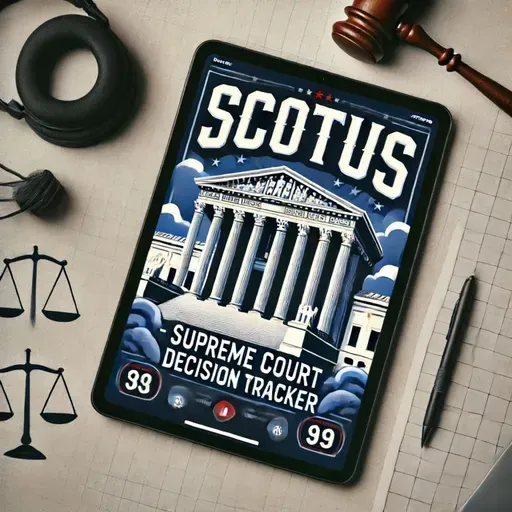
08 September 2025
Headline: Supreme Court Faces Intensifying Scrutiny Over 'Shadow Docket' and Executive Power Battles
Supreme Court Tracker - SCOTUS News
About
A major focus right now at the Supreme Court is the intensifying scrutiny over its use of the emergency, or “shadow,” docket. According to NBC News and commentary on The Daily Beans podcast, ten federal judges have publicly criticized the Court’s increasing reliance on this emergency process, raising concerns about the lack of transparency and accountability in deciding high-stakes legal questions without full briefings or oral arguments. This rare move, involving sitting judges giving interviews, signals mounting tension and divided opinion throughout the federal judiciary.
Meanwhile, attention is turning to an expedited Supreme Court case involving the Trump administration’s authority to impose broad national security tariffs under the International Emergency Economic Powers Act. The Federal Circuit found the tariffs unlawful, arguing that Congress had not clearly given the President such sweeping tariff power, and this decision is already causing international uncertainty and economic dislocation, as Reuters has reported. The administration and the opposing parties have agreed on a fast-tracked hearing schedule that could see briefs and oral argument take place before the end of the year, making this one of the most consequential cases currently before the Justices, with huge implications for executive power and U.S. economic policy.
In addition, federal courts outside the Supreme Court have recently ruled against several of the administration’s controversial actions, including planned mass deportations, deploying the National Guard in American cities, and funding cuts to states and universities. These defeats are expected to make their way up to the Supreme Court, underscoring how the Court will soon be forced to address the legal boundaries of recent executive branch initiatives. SCOTUSblog indicates that the Trump administration is seeking alternative legal footing to maintain its policy priorities, confident that the conservative majority may ultimately side with executive authority.
There’s also a spotlight on internal tensions within the judiciary, following recent public exchanges between Justice Neil Gorsuch and lower court judges about how binding the Court’s emergency orders truly are. Former Justice Stephen Breyer has emerged to defend a trial judge recently criticized by Gorsuch, describing him as honest and respectful of the Supreme Court, which both highlights and complicates the ongoing debate about judicial hierarchy and respect within the federal courts.
To summarize, the Supreme Court faces pressure from both within the judiciary and the public to clarify its approach to the emergency docket and to rule on defining questions about presidential authority in trade and immigration. All of these developments suggest a period of unusual visibility, political stakes, and institutional debate for the highest court in the United States.
Thanks for tuning in and don’t forget to subscribe. This has been a quiet please production, for more check out quiet please dot ai.
For more http://www.quietplease.ai
Get the best deals https://amzn.to/3ODvOta
Meanwhile, attention is turning to an expedited Supreme Court case involving the Trump administration’s authority to impose broad national security tariffs under the International Emergency Economic Powers Act. The Federal Circuit found the tariffs unlawful, arguing that Congress had not clearly given the President such sweeping tariff power, and this decision is already causing international uncertainty and economic dislocation, as Reuters has reported. The administration and the opposing parties have agreed on a fast-tracked hearing schedule that could see briefs and oral argument take place before the end of the year, making this one of the most consequential cases currently before the Justices, with huge implications for executive power and U.S. economic policy.
In addition, federal courts outside the Supreme Court have recently ruled against several of the administration’s controversial actions, including planned mass deportations, deploying the National Guard in American cities, and funding cuts to states and universities. These defeats are expected to make their way up to the Supreme Court, underscoring how the Court will soon be forced to address the legal boundaries of recent executive branch initiatives. SCOTUSblog indicates that the Trump administration is seeking alternative legal footing to maintain its policy priorities, confident that the conservative majority may ultimately side with executive authority.
There’s also a spotlight on internal tensions within the judiciary, following recent public exchanges between Justice Neil Gorsuch and lower court judges about how binding the Court’s emergency orders truly are. Former Justice Stephen Breyer has emerged to defend a trial judge recently criticized by Gorsuch, describing him as honest and respectful of the Supreme Court, which both highlights and complicates the ongoing debate about judicial hierarchy and respect within the federal courts.
To summarize, the Supreme Court faces pressure from both within the judiciary and the public to clarify its approach to the emergency docket and to rule on defining questions about presidential authority in trade and immigration. All of these developments suggest a period of unusual visibility, political stakes, and institutional debate for the highest court in the United States.
Thanks for tuning in and don’t forget to subscribe. This has been a quiet please production, for more check out quiet please dot ai.
For more http://www.quietplease.ai
Get the best deals https://amzn.to/3ODvOta